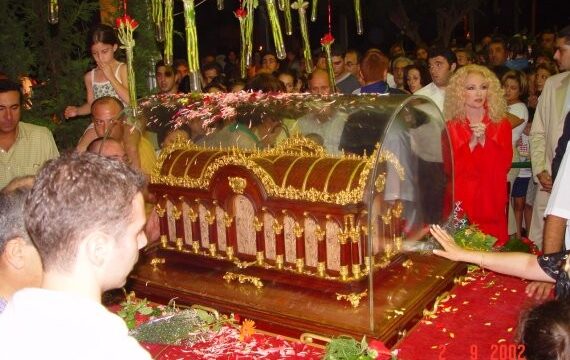
BEIRUT (AsiaNews): War between Iran and Israel broke out on June 13 the day that the relics of St. Thérèse of Lisieux arrived in Lebanon, to tour Christian towns and villages on a mission of peace and intercession in a region stricken by conflict.
Accompanied by Father Olivier Ruffray, former rector of the Lisieux shrine, the procession of the relics has been followed daily by two of the country’s major television stations.
“St. Thérèse was welcomed like a personality; personally, I felt her alive, as if she were there in person,” said Suzanne A., an economics student who was at the procession at Notre-Dame Church in Jounieh.
For the organising committee, chaired by Father Michel Abboud, president of Caritas Lebanon, despite certain excesses, mainly due to the sometimes hasty procession of schoolchildren and visitors before the reliquary, this form of popular piety stands up to criticism, being firmly anchored in Church doctrine.
“Normally, it takes between one and two years for a request to be received,” said businessperson, Fady Fayad, a member of the Jounieh municipal council, the only lay member of the organising committee. “But we benefited from the cancellation of one of the planned visits, and the coincidence of their arrival in Lebanon and the Israel-Iran war was purely coincidental.”
St. Thérèse was welcomed like a personality; personally, I felt her alive, as if she were there in person
Vincentian Father Ramzi Jreige, visiting from the congregation’s Eastern Province remarked, “Catechesis must accompany the journey of the relics, so that they may be an encouragement for the faithful to undertake the same path to holiness.”
Father Jreige explained, “To ensure that visiting these relics is not like visiting a museum, and that touching the reliquary window is not a purely mechanical and superstitious gesture, the conditions for a personal encounter with Christ must be created;”
Archbishop Paolo Borgia, the apostolic nuncio, said, “It’s a good initiative. But it’s a matter of sowing seeds.”
The archbishop said, “The important thing is to take Thérèse of Lisieux as a model. There is nothing extraordinary in her life. Her greatness lies in the love of God, according to the words of Our Lord: ‘unless a grain of wheat falls to the ground and dies, it remains just a grain of wheat; but if it dies, it produces much fruit’.”
The nuncio is not bothered by the exuberant welcome given to the relics, with rose petals, handfuls of rice, swirls of incense, hymns, and chimes. “She is well received,” he says. “I myself am sometimes welcomed like that. It’s the joy of receiving, the sense of Eastern hospitality.”
That said, what explains Thérèse of Lisieux’s great popularity in Lebanon and around the world? What drives so many Lebanese families to give her name to their daughters?
According to Fayad, the Maronite Church has forged close ties with this great saint. Lebanon can claim that it had the first convent outside France bearing her name in 1927, in Sehaileh [Keserwan].
In 2016, Patriarch Bechara al-Rahi inaugurated a Chapel of Lebanon in Lisieux. Moreover, this was the second visit of the relics of “Little Thérèse” to Lebanon, after the one of 2001, which many still remember with wonder.
The pilgrimage of her relics in Lebanon will end on July 20. Until then they will be in south Lebanon for a few days, a key region in a conflict that is struggling to find a solution.








